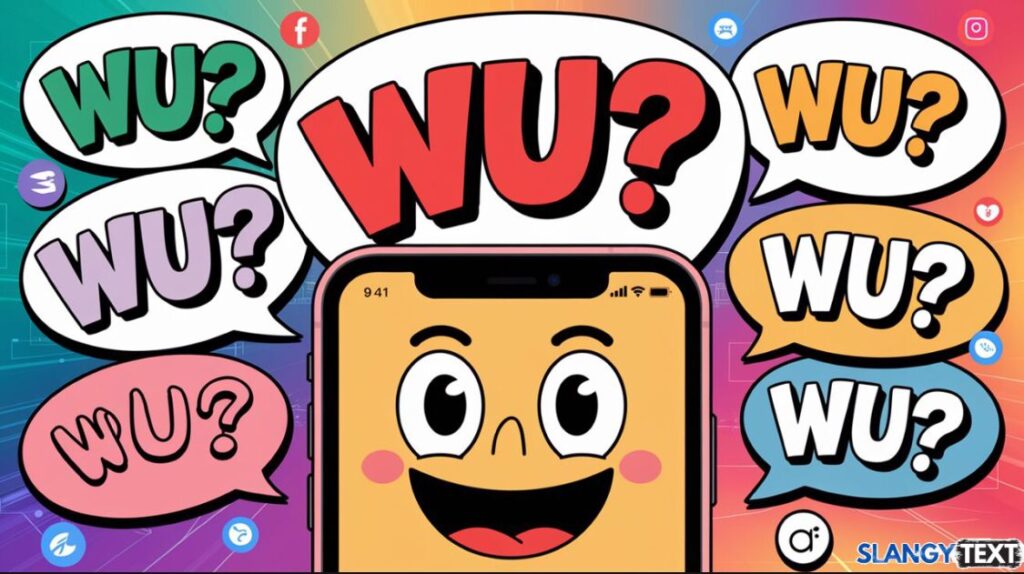What exactly does WU meaning in the context of text and online conversations?In the fast-paced world of digital communication, acronyms and shorthand have become essential tools for quick and efficient messaging.
Among these, “WU” stands out as a versatile and widely used expression.
The Origins of WU
WU is an acronym that typically stands for “What’s Up?” This casual greeting has its roots in everyday spoken language and has seamlessly transitioned into the realm of texting and social media. The use of WU as a short form for “What’s Up?” gained popularity as people sought faster ways to initiate conversations in the digital age.
WU Across Social Media Platforms
The use of WU has spread across various social media platforms, each with its own nuances and contexts. From Facebook to Instagram, Snapchat to TikTok, WU has found its place in countless text conversations.
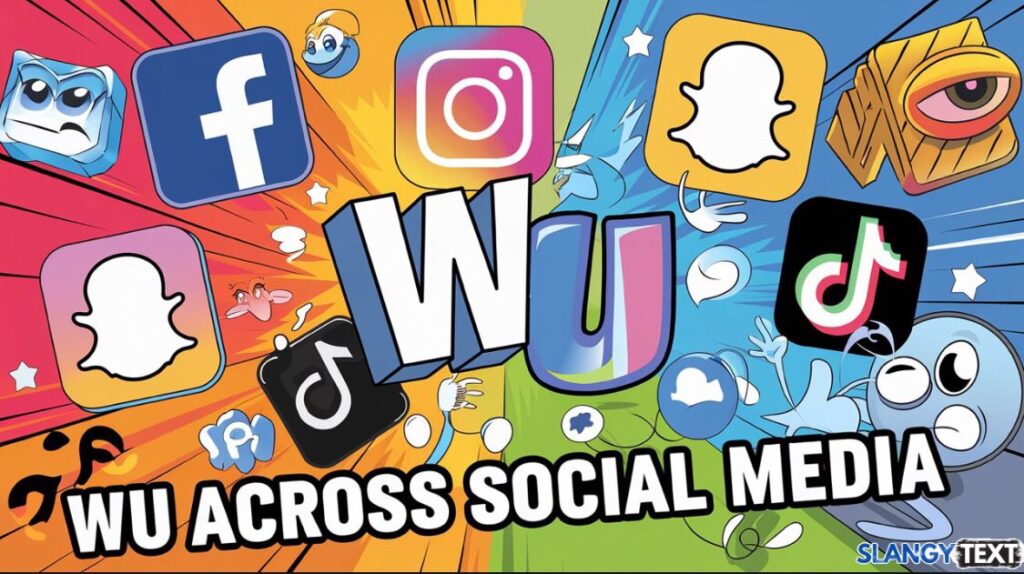
Facebook Chats and WU
On Facebook, WU often appears in Messenger chats as a quick way to start a conversation. Here’s a table showcasing how different users might employ WU in their Facebook interactions:
| Sender | Message | Context |
|---|---|---|
| Emily | “WU, Jason? Haven’t seen you online in ages!” | Reconnecting with an old friend |
| Michael | “WU with that project we discussed?” | Following up on a work-related matter |
| Sarah | “WU this weekend? Any plans?” | Making social plans |
| David | “WU with all those vacation pics? Looks amazing!” | Commenting on recent posts |
| Rachel | “WU, fam? Missing you all!” | Checking in with family members |
| Kevin | “WU with the study group? Still on for tonight?” | Coordinating with classmates |
| Olivia | “WU, bestie? Coffee date soon?” | Reaching out to a close friend |
| Daniel | “WU with the job hunt? Any luck?” | Inquiring about a friend’s career progress |
| Sophia | “WU, book club? Next meeting date?” | Organizing a social group |
| Ryan | “WU with that new recipe you tried? Was it good?” | Discussing shared interests |
also like to know this : What Does WRD Mean In Text?
Instagram and the WU Phenomenon
On Instagram, WU often appears in direct messages and comments, serving as a casual way to engage with friends and followers. The informal curiosity expressed by WU fits well with Instagram’s visual and interactive nature.
The Emotion Behind WU
When someone sends you a message starting with WU, they’re often expressing a friendly and casual interest in your current state or activities. It’s a relaxed way to initiate conversation and catch up with someone without the formality of a more structured greeting.
WU and its Emotional Undertones
The use of WU can convey various emotional states depending on the context and relationship between the communicators. Here’s a table illustrating different emotional undertones associated with WU:
| Sender | Message | Emotional Undertone |
|---|---|---|
| Alex | “WU, Emma? Haven’t heard from you in a while.” | Concern and curiosity |
| Jessica | “WU, party people? Ready for tonight?” | Excitement and anticipation |
| Tyler | “WU with that gloomy status? Everything okay?” | Empathy and support |
| Mia | “WU, boss? Got a minute to chat?” | Respectful inquiry |
| Ethan | “WU, sunshine? Missed your smile today.” | Affection and flirtation |
| Ava | “WU with the world? Feeling philosophical today.” | Contemplative mood |
| Noah | “WU, team? Big game tomorrow!” | Motivation and team spirit |
| Lily | “WU, grumpy cat? Need some cheering up?” | Playful teasing |
| Liam | “WU, brain? Writer’s block hitting hard.” | Self-reflection and frustration |
| Zoe | “WU, universe? Feeling lucky today!” | Optimism and positivity |
WU in Different Contexts
The versatility of WU allows it to be used in various situations, from casual check-ins to more specific inquiries. Let’s explore some common scenarios where WU might appear in text conversations.
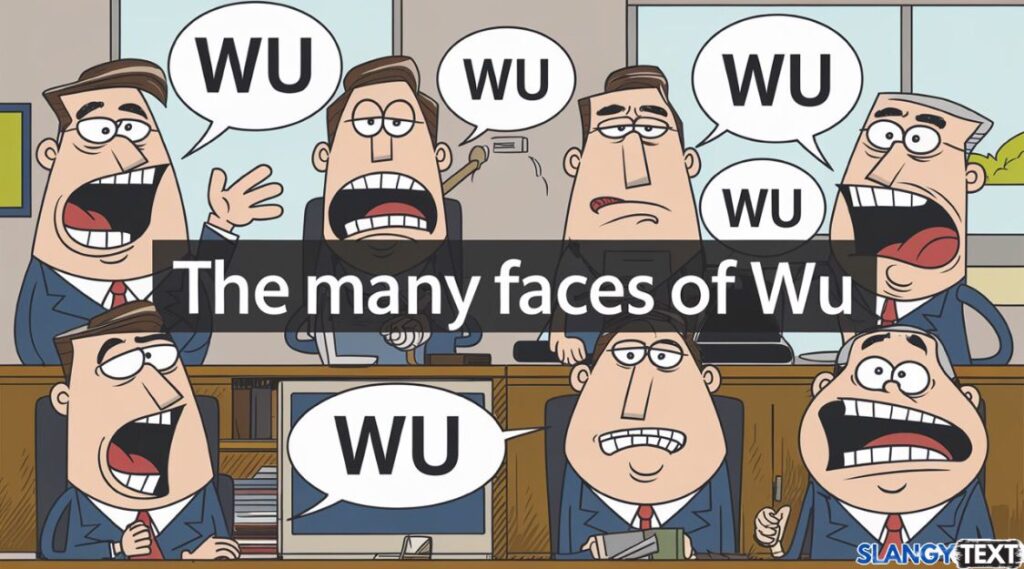
Catching Up on Work Matters
In a professional context, WU can be used to inquire about the progress of a new project or ongoing work tasks. However, it’s important to gauge the level of formality required in your workplace before using such acronyms.
The Casual Check-In
When friends haven’t spoken for a while, WU serves as a perfect opener to see what someone’s been up to. It’s a way of asking if they’ve been taking it easy or if life has been hectic.
WU and Its Audience Appropriateness
While WU is widely used, it’s crucial to consider the audience when deciding whether to use this acronym. Understanding the appropriate contexts for slang usage can help avoid miscommunications.
WU in Family Communications
Many wonder if WU is safe for children to use or if it’s parent-friendly. Generally, WU is considered an innocent and informal use of language that doesn’t carry any inappropriate connotations.
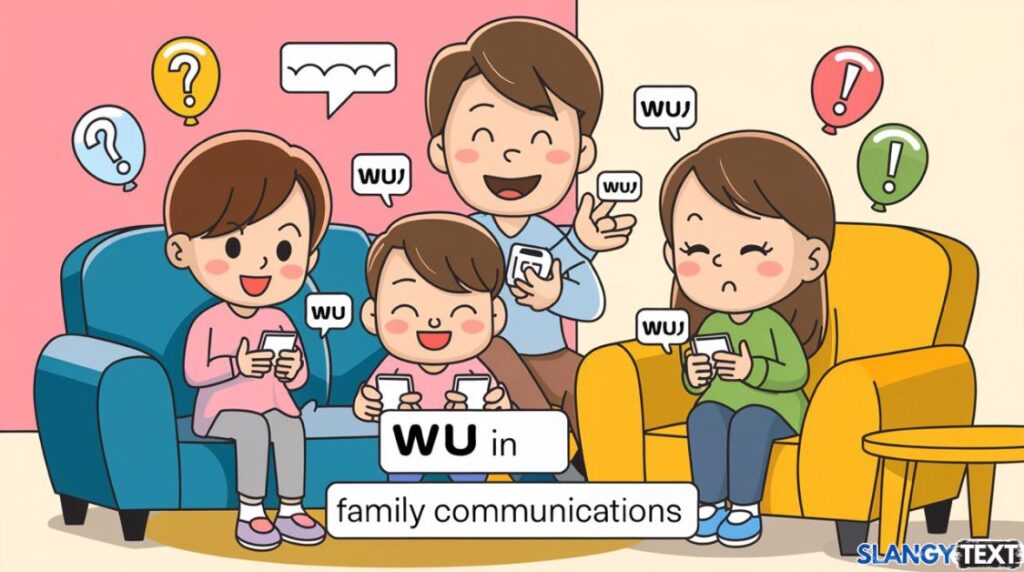
WU in Educational Settings
In educational relevance, WU might be discussed as part of modern language evolution. However, its use in formal academic writing or communications is typically discouraged due to its informal nature.
WU in Business Communications
When it comes to business formality, WU is generally considered too casual for most professional settings. It’s best reserved for internal communications with close colleagues rather than formal business correspondence.
You might also like: What Does HMU Mean In Texting?
Real-life Examples of WU in Action
To better understand how WU is used in everyday digital communication, let’s look at some real-life examples and scenarios. These quick replays of text exchanges will illustrate the various ways WU can be employed.
Post-Event Follow-Up
After a social gathering, WU can be used to check in on friends and see how they’re doing. Here’s a table showing various post-event follow-up scenarios using WU:
| Sender | Message | Context |
|---|---|---|
| Jake | “WU, party animal? Recovered from last night?” | Checking in after a wild night out |
| Sophia | “WU, dance queen? Feet still sore from all that dancing?” | Following up after a dance event |
| Ethan | “WU, karaoke king? Voice holding up okay?” | Inquiring after a karaoke night |
| Isabella | “WU, marathon runner? How’s the post-race feeling?” | Checking on a friend after a race |
| Mason | “WU, birthday girl? Still on a cake high?” | Following up after a birthday celebration |
| Ava | “WU, graduate? Settled into post-college life yet?” | Catching up after a graduation ceremony |
| Lucas | “WU, newlyweds? Back from honeymoon bliss?” | Checking in with recently married friends |
| Emma | “WU, festival goer? Ears still ringing from the music?” | Following up after a music festival |
| Oliver | “WU, debate champ? Voice recovered from all that arguing?” | Inquiring after a debate competition |
| Mia | “WU, theater star? Post-performance blues kicking in?” | Checking on an actor friend after a show |
Morning Greetings
WU can be a cheerful way to start the day with friends or family. It’s often used to inquire about someone’s morning routine or plans for the day ahead.
Weekend Anticipation
As the weekend approaches, WU might be used to gauge friends’ plans or excitement levels. It’s a casual way to start planning social activities or simply share in the anticipation of free time.
Other Meanings of WU
While WU primarily means “What’s Up?” in texting, it’s worth noting that it can have other meanings in different contexts. For instance, WU can also stand for Western Union, a company known for sending money internationally. However, in the context of casual texting, it’s almost always safe to assume WU means “What’s Up?”
WU in Various Industries
To illustrate the diverse meanings of WU across different fields, here’s a table showing some alternative interpretations:
| Industry | WU Meaning | Example Usage |
|---|---|---|
| Finance | Western Union | “I’ll send the money via WU tomorrow.” |
| Education | Wake-Up (call) | “Don’t forget to set your WU for the early class.” |
| Music | Wu-Tang Clan | “Have you heard the latest WU album?” |
| Technology | Wireless Unit | “The WU isn’t connecting to the network.” |
| Sports | Warm-Up | “The team is doing their WU exercises.” |
| Aviation | Weather Update | “Pilots, check the latest WU before takeoff.” |
| Healthcare | Wound Unit | “The patient has been transferred to the WU.” |
| Hospitality | Wake-Up (service) | “Would you like a WU call in the morning, sir?” |
| Military | Weapons Unit | “The WU is conducting training exercises today.” |
| Environmental | Water Usage | “We need to reduce our WU to conserve resources.” |
Also like to know this : What Does Guerito Mean in Texting (TikTok & Social Media)
The Evolution of WU in Digital Communication
As digital platforms continue to evolve, so does the usage of acronyms like WU. What started as a simple texting shorthand has become an integral part of online social interactions, reflecting the casual and friendly nature of many digital exchanges.
WU and Generational Differences
Interestingly, the use of WU can vary across different age groups. Younger generations might use it more frequently and in more diverse contexts, while older individuals might prefer spelling out “What’s Up?” in full.
Mastering the Art of WU
To effectively use WU in your digital communications, it’s essential to understand its nuances and appropriate contexts. Here’s a table showcasing different ways to respond to WU, depending on the situation:
| Scenario | WU Message | Possible Response |
|---|---|---|
| Friend checking in | “WU, buddy?” | “Not much, just chilling. You?” |
| Colleague before a meeting | “WU with the project?” | “On track, will update in the meeting.” |
| Family member on a weekend | “WU, sis? Plans today?” | “Thinking of hitting the beach. Join?” |
| Crush texting late night | “WU, cutie? Can’t sleep.” | “Just watching a movie. Wanna chat?” |
| Old friend reconnecting | “WU after all these years?” | “Life’s been an adventure! Let’s catch up!” |
| Roommate from the next room | “WU? Heard a noise.” | “Sorry, just dropped my book. All good!” |
| Teacher to student group | “WU, class? Ready for the test?” | “Studying hard! Any last-minute tips?” |
| Gym buddy on a rest day | “WU, gains? Skipping leg day?” | “Never! Just taking a recovery day.” |
| Band mate before practice | “WU? Still on for rehearsal?” | “Yep, tuning my guitar now. See you soon!” |
| Online gaming friend | “WU, player? Ready to level up?” | “Born ready! Logging in now.” |
The Future of WU and Digital Shorthand
As language continues to evolve in the digital age, acronyms like WU may change in usage or meaning. However, the need for quick, efficient communication suggests that such shorthand will remain a part of our digital lexicon for the foreseeable future.
Adapting to New Communication Trends
While WU has stood the test of time in digital communication, new acronyms and shorthand continually emerge. Staying aware of these trends can help you communicate effectively across various digital platforms and with different age groups.
Concluding Thoughts on WU
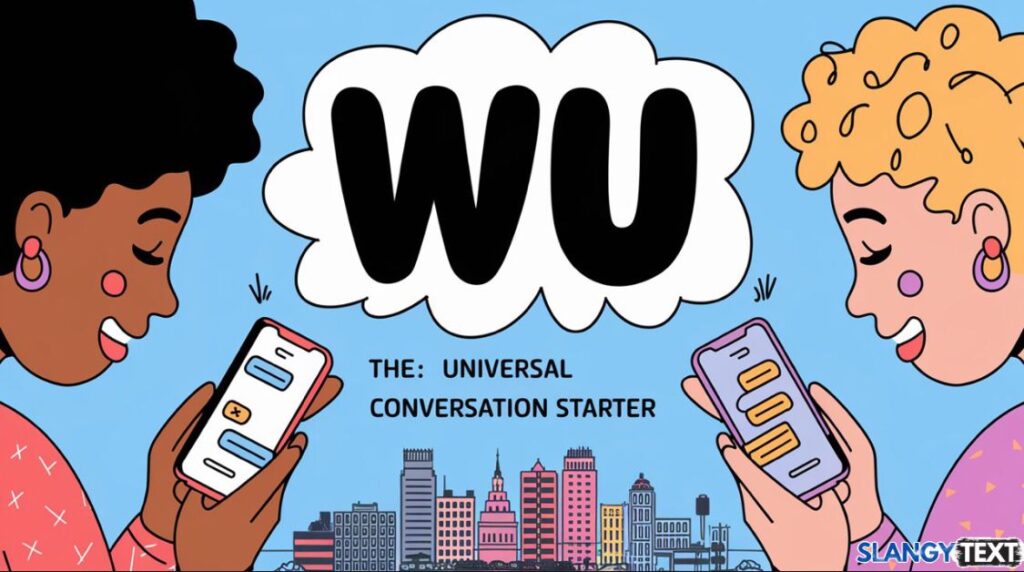
In the ever-changing landscape of digital communication, WU stands as a testament to our desire for quick, friendly interactions. Whether you’re checking in with a friend, starting a conversation with a colleague, or simply expressing curiosity about someone’s day, WU offers a versatile and widely understood way to connect.
As we navigate the complex world of online interactions, remembering the context and audience for our messages is crucial. While WU might be perfect for a casual chat with friends, it may not be suitable for more formal communications. By understanding these nuances, we can use WU and similar shorthand effectively, enhancing our digital conversations and maintaining meaningful connections in our fast-paced, technology-driven world.
You might like : What Does WYF Mean In Texting?

Kayla Rogers is a writer at Slangy Text who loves exploring modern acronyms & slangs and how they shapes our conversations. She enjoys sharing fun and interesting articles that connect with readers. When she’s not writing, Kayla likes to keep up with the latest trends or relax with a good book.

